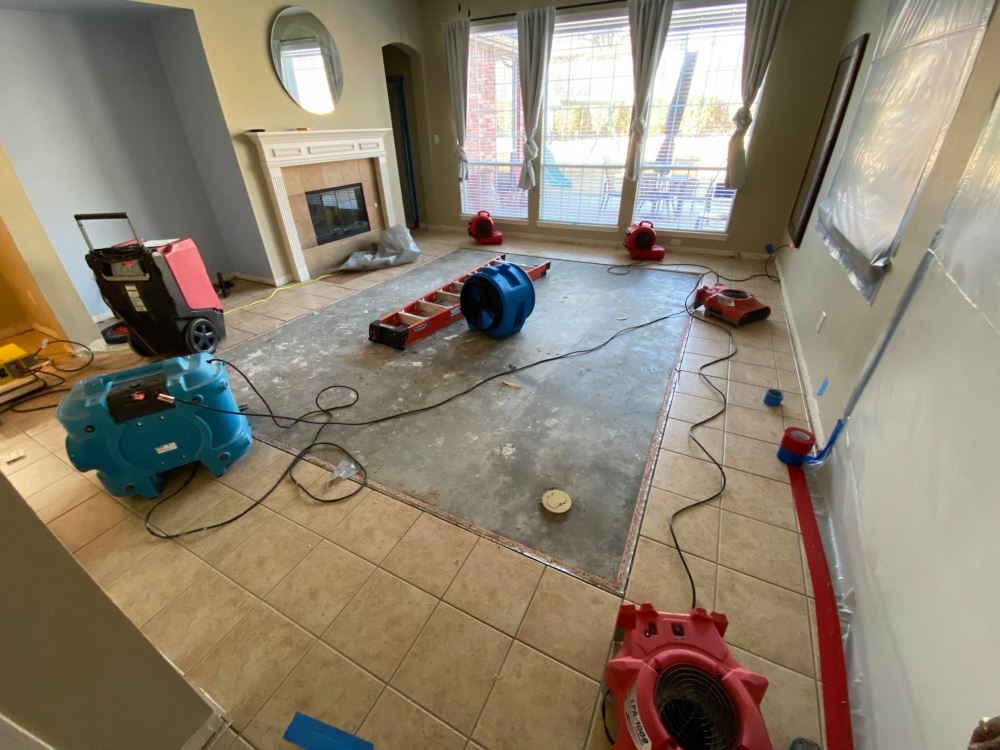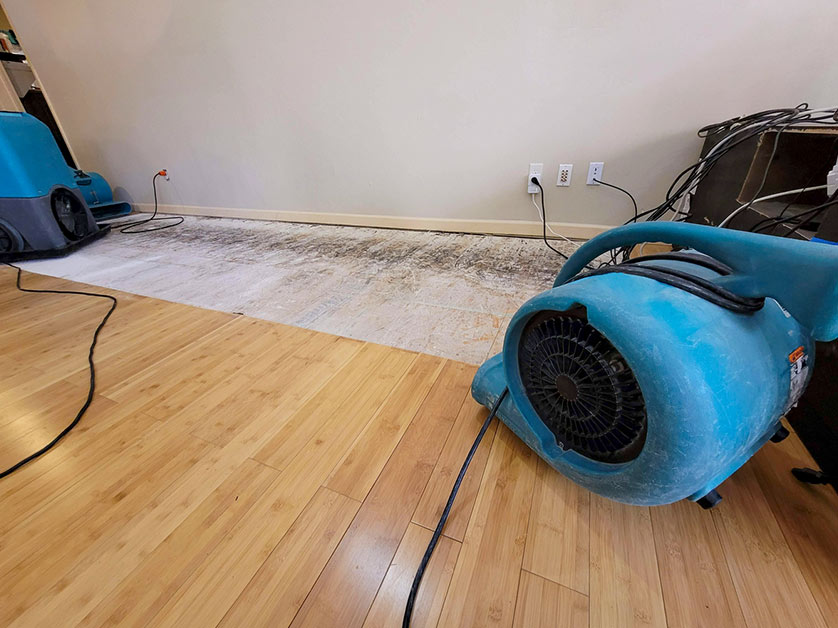Water Damage Restoration 101: Comprehending the Process and Price
Water damage can strike unexpectedly, leaving house owners in a state of complication. Comprehending the reconstruction process is essential for reliable recuperation. From evaluating the damage to picking the right company, each action influences the total result and price. Variables such as the sort of water damage and urgency additionally play a significant role. What are the specific strategies utilized in repair, and exactly how can one get ready for potential expenses?
Kinds Of Water Damage

Preliminary Analysis and Inspection

Water Removal Strategies
Complying with the preliminary assessment, effective water removal techniques are utilized to mitigate damage and prevent further issues. These strategies include using specific tools such as industrial-grade vacuums and completely submersible pumps - Mold Remediation After Water Damage. The choice of method depends on the volume of water existing and the kind of products influenced. For standing water, completely submersible pumps are commonly used for quick removal, while vacuums are excellent for extracting water from carpets and upholstery. Furthermore, advanced approaches like water removal mats might be employed for hard-to-reach areas - Water Damage Restoration. The goal is to remove as much water as feasible, minimizing the capacity for mold growth and architectural damage. Prompt and effective water removal is necessary in the general water damage remediation procedure
Drying Out and Dehumidification Process
When the water extraction is full, the drying and dehumidification procedure comes to be important to restoring the damaged area. This phase typically utilizes industrial-grade dehumidifiers and air moving companies to successfully reduce moisture degrees. The dehumidifiers attract damp air, getting rid of excess moisture, while air moving companies flow air to speed up evaporation. Monitoring tools is commonly used to track moisture and temperature levels, making sure excellent drying out conditions. The period of this process can vary depending on the level of the water damage and environmental elements. It is necessary to completely dry all influenced materials, including wall surfaces, floor covering, and furnishings, to stop mold and mildew development and architectural damage. Appropriate execution of this step is critical for an effective remediation result.
Cleaning Up and Sanitizing Afflicted Areas
A thorough initial evaluation and assessment of impacted locations is essential to identify contamination degrees when the drying out procedure is complete. Water Damage Restoration. Reliable cleansing methods and ideal items need to after that be employed to eliminate particles and discolorations. Sanitization and sanitation techniques are essential to ensure that harmful virus are removed, recovering the area to a safe problem.
First Assessment and Inspection
Before beginning any kind of restoration initiatives, an extensive initial evaluation and inspection of the influenced locations are crucial for efficient cleansing and sterilizing. This procedure entails recognizing the level of water damage, figuring out the source of the water invasion, and reviewing the products influenced. Inspectors usually search for signs of mold development, architectural honesty problems, and damaged valuables. The evaluation also consists of examining wetness levels utilizing specialized equipment to guarantee no concealed water pockets stay, as these can cause further issues. Documenting the findings is necessary for intending the following action in the reconstruction process. An in-depth initial evaluation allows restoration experts to design a targeted technique for efficient cleaning and sterilizing, ultimately reducing damage and health and wellness risks.
Cleaning Strategies and Products
Reliable cleaning and disinfecting of water-damaged locations call for a variety of techniques and items tailored to the particular materials impacted. For permeable surface areas like drywall and carpeting, removal approaches are important to remove excess wetness, followed by deep cleaning with specialized cleaning agents. Non-porous products such as floor tile or metal can be cleaned using commercial-grade cleansers that efficiently remove pollutants. Steam cleaning is another efficient method, especially for rugs and upholstery, as it uses heats to remove bacteria and mold and mildew (Water Damage Restoration). In addition, environment-friendly products are progressively popular for their safety and security and efficacy - Water Extraction And Drying. Ultimately, selecting the ideal cleaning techniques and products not just guarantees immediate tidiness yet likewise aids in stopping further damage and carcinogen connected with water invasion
Sanitization and Disinfection Methods
When addressing water damage, appropriate sanitization and sanitation methods are vital to assure the security and health of the afflicted atmosphere. After initial cleansing, surface areas must be treated with proper disinfectants to eliminate virus, mold and mildew, and bacteria that thrive in damp conditions. Typical approaches consist of the usage of EPA-approved chemical disinfectants, which can be used via splashing or cleaning methods. In addition, ultraviolet (UV) light systems can effectively sanitize locations by reducing the effects of microbes without harsh chemicals. The selection of technique often depends on the kind of materials affected and the extent of contamination. Eventually, complete sanitization not just recovers a risk-free living space but likewise helps prevent future health and wellness dangers connected with remaining dampness and mold and mildew development.

Fixings and Restoration Options
Assessing the damage triggered by water exposure is essential for figuring out the appropriate repair work and repair alternatives. House owners might deal with various concerns, including damaged drywall, warped flooring, and compromised structural components. Depending upon the degree of the damage, repairs may entail changing sections of drywall, setting up new floor covering, or strengthening architectural beam of lights. In situations of extreme damage, total substitute of afflicted materials may be required. Furthermore, expert restorers commonly suggest utilizing moisture meters to analyze read the article concealed dampness degrees prior to selecting the very best strategy. It is necessary to act without delay to stop mold development and further damage. Selecting the best options not only recovers the residential property but additionally ensures long-term safety and performance.
Elements Affecting Restoration Costs

The degree of water damage directly impacts the remediation costs homeowners can expect to sustain. Aspects such as the source of the water, the duration of exposure, and the afflicted materials greatly affect pricing. For circumstances, tidy water damage from a damaged pipe is usually much less costly to bring back compared to damage triggered by sewer. Furthermore, the level of contamination determines the need for specialized cleaning and disposal solutions, further raising costs. Geographic location likewise plays a function, as regional labor prices and accessibility of remediation solutions can differ. The necessity of the response impacts costs; quicker treatments typically lead to lower general expenses by protecting against further damage. Recognizing these variables is important for property owners when estimating repair prices.
The three primary kinds of water damage are categorized based on contamination degrees: clean water, gray water, and black water. A complete preliminary analysis and examination are vital actions in the water damage restoration procedure. For standing water, completely submersible pumps are usually made use of for quick elimination, while vacuum cleaners are excellent for extracting water from carpets and upholstery. The extent of water damage directly impacts the restoration sets you back homeowners can anticipate to incur. Tidy water damage from a broken pipeline is typically much less costly to restore contrasted to damage created by sewage.